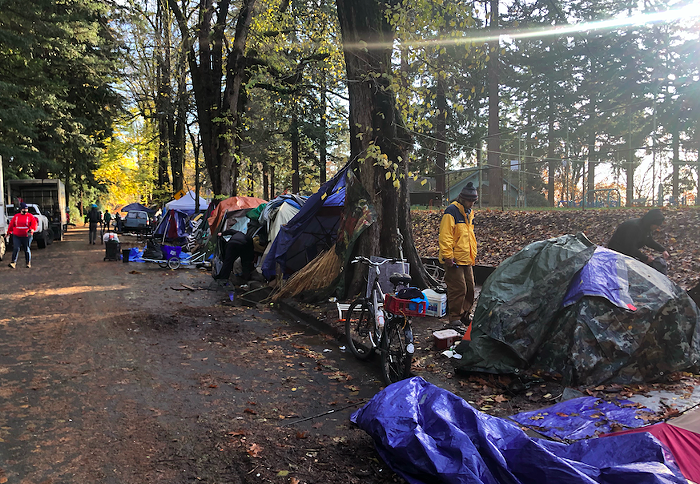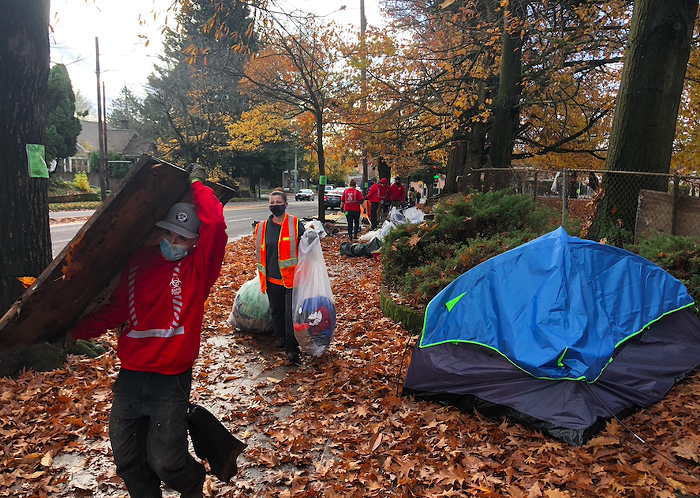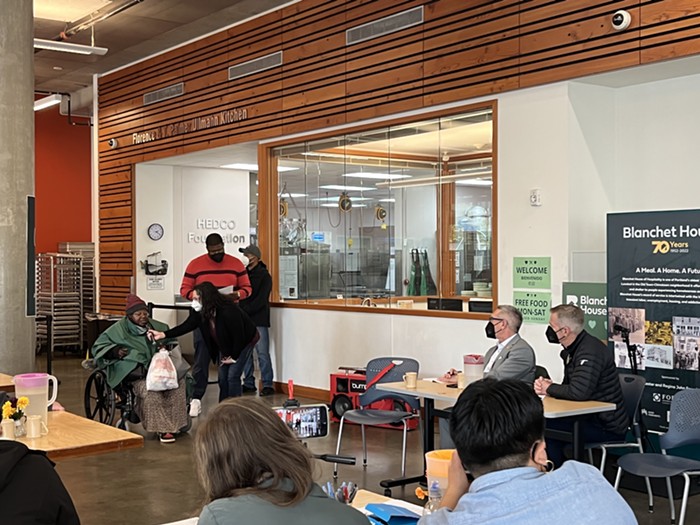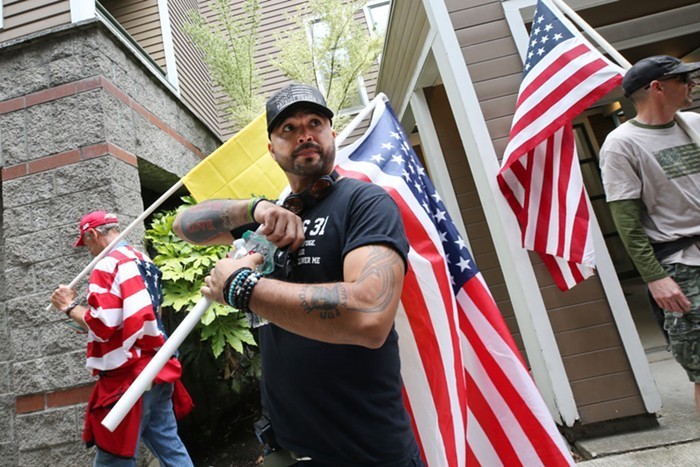Following outcry from businesses in Portland’s Central Eastside Industrial District, city leaders have partnered with neighborhood representatives to develop a 90-day plan to improve perceptions of public safety in the district. The plan, unveiled during a press conference Thursday, aims to increase police presence in the district, improve lighting, remove graffiti, clean up trash, and remove homeless people from the neighborhood’s streets—despite evidence that those same people will just be displaced to another part of the city instead of connected to long term housing services.
“To those that call the Central Eastside home, it is time to turn a page and start a new chapter,” said Claire Briglio, Executive Director of the Central Eastside Industrial Council, during a press conference Thursday. “It must change because the old ways are not working and we know that so very clearly now.”
In November, about 140 business owners in Portland’s Central Eastside met with Mayor Ted Wheeler, Police Chief Chuck Lovell, and other regional leaders to raise concerns about safety in the district. The listening session followed news of Salt and Straw CEO Kim Malek saying she would consider moving the ice cream headquarters out of Portland if city leaders did not do more to address drug use, street camping, and crime in the city. Several business representatives at the forum said that their employees felt unsafe coming to work, with Malek noting that one of her employees had been held at gunpoint in the Central Eastside.
Following that forum, members of Wheeler’s office met with neighborhood members to develop a “90-day Reset Plan,” similar to the city’s “reset” of Old Town in May and April 2022, during which the city conducted mass sweeps of homeless campers and increased police presence in an effort to deter crime and increase foot traffic in the neighborhood. At the time, Wheeler said that he wanted to do similar “resets” in other areas of the city.
The Central Eastside reset plan includes removing camps that are deemed a health and safety risk by the Impact Reduction Program, the city program responsible for coordinating camp removals. While business owners in the Central Eastside were able to highlight priority zones in the neighborhood where they believe camps should be removed first—like areas with a number of significant retail shops and restaurants—the Impact Reduction Program will continue to sweep camps based on its standard assessment of health and safety risks. The city will also prioritize cleaning up graffiti, increase trash receptacles and pick-up in the district, and add more lighting under bridges in an effort to deter crime. The Portland Police Bureau will also increase its patrolling in the district, switching from one or two officers in the area up to 10 who look for stolen cars, arrest people for drug use, and talk to business owners about any criminal concerns they have in the neighborhood.
Wheeler said that homeless Portlanders who are swept during the next 90 days will be offered a shelter bed, an immediate ride to that shelter bed, and a place to store any additional belongings that they cannot take to the shelter. Most shelter beds in Portland operate on a night-by-night basis, meaning Portlanders have to leave during the day and come back. An analysis of the Old Town reset sweeps by the Oregonian found that the city could not confirm the people forced to leave Old Town moved to a shelter for more than a single night, and most unhoused Portlanders declined being moved to a shelter at all.
One unhoused Portlander caught in the Old Town sweeps told the Mercury in June that it felt like “psychological warfare,” noting that he couldn’t get into a shelter with his dog and having to constantly move disrupted his ability to find work.
While Old Town business owners celebrated the reduction of visible homelessness and decrease in crime in the neighborhood following the reset, the city could not provide any evidence that issues of homelessness and crime had been addressed rather than dispersed to other parts of the city.
Wheeler acknowledged this reality during Thursday’s press conference, noting that previous sweeps have not led to getting homeless residents into housing. According to Wheeler, city outreach workers found that two out of 10 unhoused Portlanders say they will not go to an indoor shelter, including nightly shelters and motel rooms. The mayor believes that data underscores the importance of his plan to create six large, sanctioned outdoor camps throughout the city.
“People may not want to go to an indoor congregate shelter, but we’re betting that a lot of people—based on what they told us—would go to a different location that is outdoors, that has stability, hygiene, and navigation to critical services,” Wheeler said.
When the mass outdoor camps were announced, several homeless Portlanders told Wheeler during a listening session that they were uncomfortable with the size of the camps. Each sanctioned outdoor camp is expected to hold at least 150 people. While unhoused Portlanders may worry about their safety in such a large setting, they may not have a choice in whether or not to stay at the planned camps—the resolutions passed by City Council in November included a policy that creates criminal penalties for homeless Portlanders who refuse to go to a shelter after the camps are built.
The city is currently reviewing applications for organizations to run the outdoor camps. At least one location for the sanctioned outdoor camps will be announced soon, Wheeler said Thursday.
As for homeless Portlanders in the Central Eastside who will be swept during the next 90-days, Wheeler acknowledged that people who do not want to go to a shelter will likely “pick up and go somewhere else.”
“All of us acknowledge that is not a solution to homelessness,” Wheeler said. “That will fix some of the problems here and now, but it’s not getting people connected to the services they need to help them get off and stay off the streets.”




















